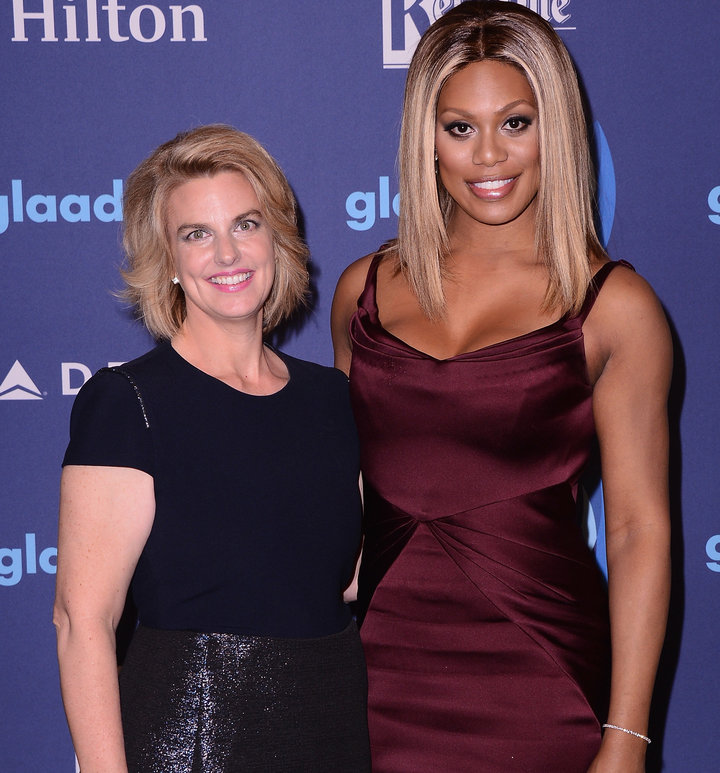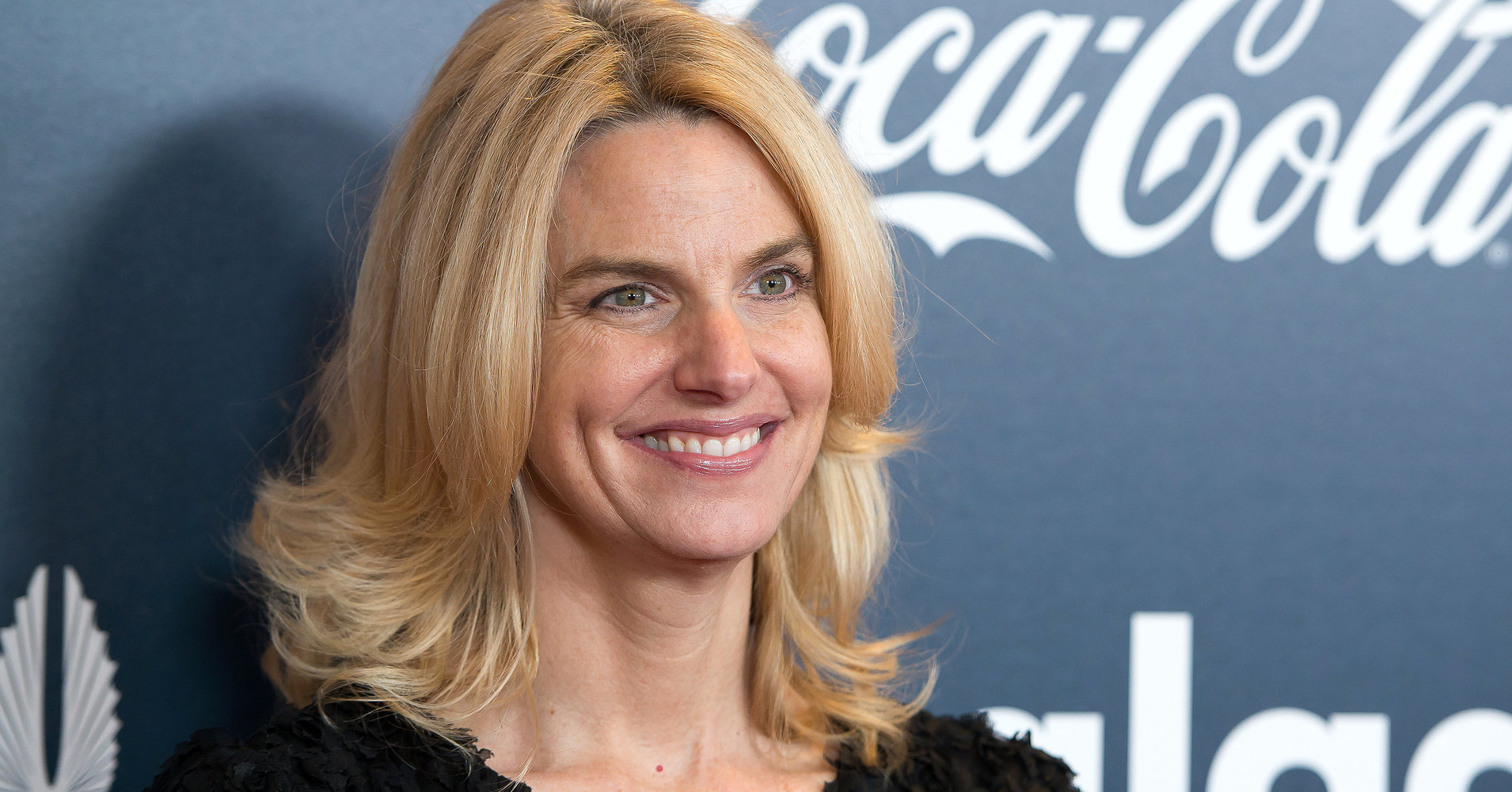[ad_1]
“I’ve always been an activist,” Sarah Kate Ellis tells HuffPost with a reverence in her voice. “I was raised that way.”
Ellis, the president of GLAAD, the largest LGBTQ media advocacy organization in the world, is a commanding figure within the queer rights movement. Hailing from a background in media at brands like Condé Nast and Time Inc., Ellis took over the reins at GLAAD in January 2014 and has, in many ways, breathed new life into the organization.
Since joining GLAAD, Ellis has been a guiding voice through some of the most defining moments for the LGBTQ community in recent memory ― the legalization of same-sex marriage, the Pulse nightclub massacre and the mainstream conversation about rights for transgender people.
And she’s done it all while raising a family with her wife, who became pregnant on the same day as her several years ago.
“I always understood the power of media and worked within the media landscape,” Ellis told HuffPost. “Coming to GLAAD and combining those two passions to do what is such purposeful work to me was a dream come true.”
Ellis reflects on her 4½ years as the president of GLAAD, how she deals with significant cultural moments for the LGBTQ community and what her idea of a queer future looks like.
Can you talk to me a bit about your life before you became the president of GLAAD and what you were up to in the years before you took over?
Certainly. My career before going into advocacy was in media. I worked in magazines from the beginning of my career starting at Condé Nast and then going over to Time Inc, and then back and forth between Condé and Time Inc. over the years. Ultimately I was at Time Inc. and overseeing, from a marketing capacity, about 13 different brands, both digital properties and print properties, before I came here.
But I was also always an activist. I was raised that way. One of my first marches in Washington was for women’s rights and for pro-choice. Then my second march in Washington I think was in 1993, God bless me, when we all descended on Washington for LGBTQ rights. So, I have a history of both media and advocacy.
My wife and I became pregnant on the same day, and with that, when I was working at Real Simple, the managing editor there asked if she could follow our dual pregnancies. At that time, I knew that Real Simple, because I worked there, had eight million female readers, mostly female who were mostly Middle America, so I thought it was great way to show Americans an LGBTQ family. So, we agreed to that, and from there we wrote a book called Times Two about our dual pregnancies. And really, what it was about was introducing America to lesbian women, lesbian families. That’s the way that we always saw it.
So I always understood the power of media and worked within the media landscape. Coming to GLAAD and combining those two passions to do what is such purposeful work to me was a dream come true.
What has been your overarching vision and mission for GLAAD since you became president?
Since I became president, one of the things that I knew very well from being in media is that you needed metrics, or otherwise known as KPIs, who love corporate terms in corporate America to tell investors what they were investing in. I’m a research hound. I love research. One of my first orders of business was to actually measure culture in America and understand how people really felt about LGBTQ people. As a cultural change agency, GLAAD’s vision and mission are to make the world a better place for LGBTQ people through cultural change, through acceptance, what we call accelerating acceptance. And so, we use seven indices with the Harris Poll to measure how people feel, and we use comfortability as the proxy, so how comfortable are you: somewhat comfortable, very comfortable, very uncomfortable.
We asked these seven questions such as, “How do you feel about a gay person moving next door to you? How do you feel about your children learning LGBTQ history in school?” and what we found was that pretty much one out of every three Americans were still uncomfortable with LGBTQ people. So, the mission of GLAAD has always been to get to that third of Americans to help them on a journey of acceptance of LGBTQ people.
We do it really in two ways. We do it through surrogates, what we call surrogates, which is through television, and actors, and celebrities, and movies, and all the pop culture that Americans look to, and globally to share our stories. Then we do it through news and journalism through real people who are put in extraordinary situations or asked to shoulder extraordinary situations and tell their stories. We know that when people know somebody LGBTQ, whether it’s through their television or it’s a neighbor, they’re more likely to be accepting. That’s our mission. That’s what we do on a daily basis.

How hard is it to do your job, which for all intents and purposes is kind of being a professional queer person, when something horrible happens in the community? Or when we’re under periods of political threat like we are right now? Do you feel like you have a chance to process that personally? Or does processing professionally kind of help you process personally?
The one example I can really point to is the Pulse nightclub shooting. It was that Sunday morning, and I was standing in my kitchen getting my kid’s breakfast ready when the head of comms for … I hadn’t turned on a TV, and I hadn’t looked at a phone that morning, because I was trying to be with my family, as we’re all trying to do these days, trying to be off for five minutes. My phone rang, which it doesn’t do unless it’s an emergency, and I answered it. And I was being briefed on that, and I thought in that moment, I absolutely thought in that moment, “There’s no time for me. There’s only time for the community here, and we have a community that has just been attacked and assaulted in a devastating way.”
And so, I think I did process it through professionally being able to be on the front lines and fight to make sure that the people who were massacred that their identities were clearly stated, that their names, and who they were as people was brought to the surface of the story and that it wasn’t about the killer. But it was about how this would affect our community, the people who were murdered. I feel today in this environment, in this culture war that we’re living in, I feel really privileged and honored to be able to wake up every morning knowing I get to fight back for us.
I couldn’t sit in an office now like I did five years ago and watch all this go on. I would have to be on the front line, so I feel really fortunate that I get to be on the front line. It does get heavy. It is nonstop, but I’ve learned, and I am ambitious as a person for our community, for our acceptance, and for our rights. I do have to carve out time for self-care. I do meditation now, which is … I am so highly strung. Watching like a hyena trying to do meditation, but I do it because I know that I’ll bring a better me to the fight.
Today [the day of the interview] actually marks six years since Obama became the first sitting U.S. president to vocalize his support for same-sex marriage. When you reflect on how far we’ve come as a movement and as a community over the past six years, is it overwhelming or what’s your headspace surrounding that just the knowledge of everything that’s happened?
I think it’s been, in my lifetime, phenomenal. I would say the people who came before us and who fought like hell to get us here, I think it probably took a really long time, so I always think it’s perspective on this because so many people lost their jobs, lost their families, lost their livelihood in paving the way to where we are today. I’m in complete awe of them, honestly. I know that it has the perception that it moved quickly, but if you ask the queer Americans from two decades ago, I would imagine it felt like at a snail’s rate.
What would you say to, maybe a young queer person how feels anxiety about kind of our current political and social climate, how can they channel those feelings into actionable change?
I think our young queer community is our future. We need them on the front lines with us more than ever. They bring such a new fresh perspective to the fight. The way that they embrace intersectionality in bringing all communities who are marginalized together is more important than ever now. So I highly advise them to get involved in what is their deepest passion and what they feel that they can bring their best self to, and to volunteer, to participate. I think that is not only healing in these very hard times, but also will help move forward our community and all communities who are suffering right now.
I think our young queer community is our future. We need them on the front lines with us more than ever.
What does Pride mean to you in 2018?
It does change. It’s different, its meaning every year. It’s kind of fascinating. In 2018, it really means resistance. It means coming together as a community and locking arms, so that we have each other’s back, and we’re pushing forward together. There are two main themes, I think, for Pride this year. One is absolutely resistance, and the other one is a sense of community.
Our HuffPost Pride coverage this year is themed #TheFutureIsQueer. I would love to hear you reflect on what is a future that is queer and inclusive look and feel like for you, particularly when you’re thinking about young people, your children, and the world that we’re trying to build together?
This is a little off, but if you’ve ever been to Provincetown, Massachusetts? That’s my vision of what a queer world looks like is where everybody, straight, cis, people of color, queer people, queer people of color, immigrants are all living together and building a world and community that is better because of the differences we have, and not torn apart by our differences. Our difference is our strength, and it’s our uniqueness. It’s a very positive thing. It’s used, currently, to divide us. I always see this magical future of all of us being treated kindly, fairly and equally in the future, no matter your race, your gender identity, your sexual orientation or your immigration status.
For LGBTQ Pride 2018, HuffPost is highlighting 30 different cultural influencers who have shifted the narrative when it comes to queer issues and whose work has contributed to building a more inclusive and equitable future for us all.
#TheFutureIsQueer is HuffPost’s monthlong celebration of queerness, not just as an identity but as action in the world. Find all of our Pride Month coverage here.
[ad_2]
Source link

